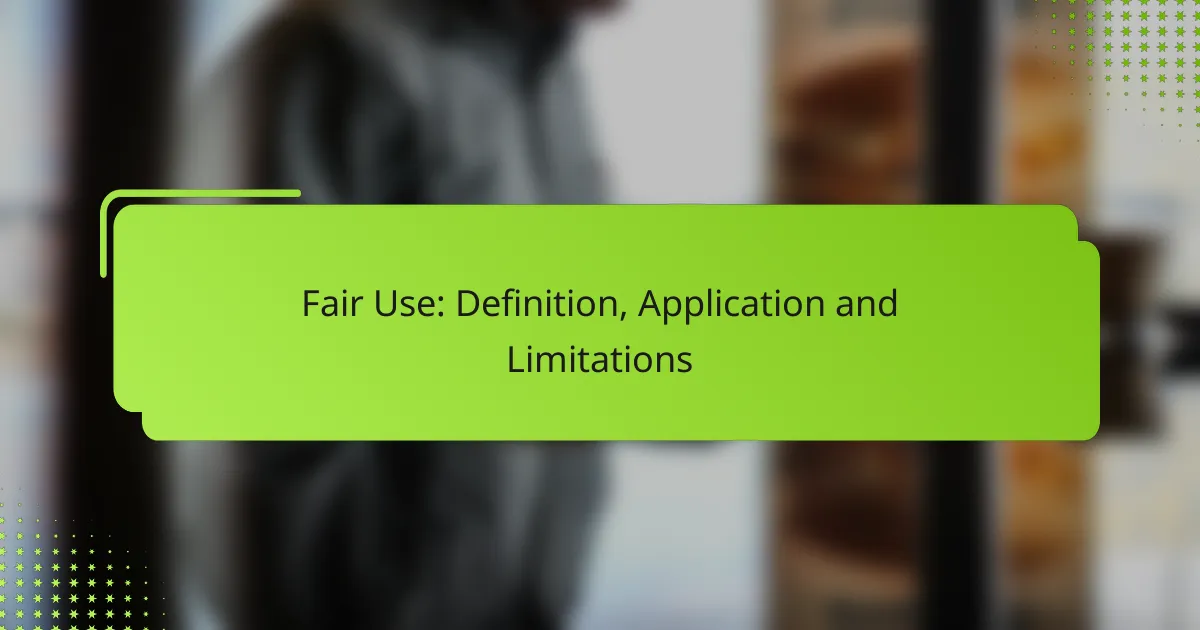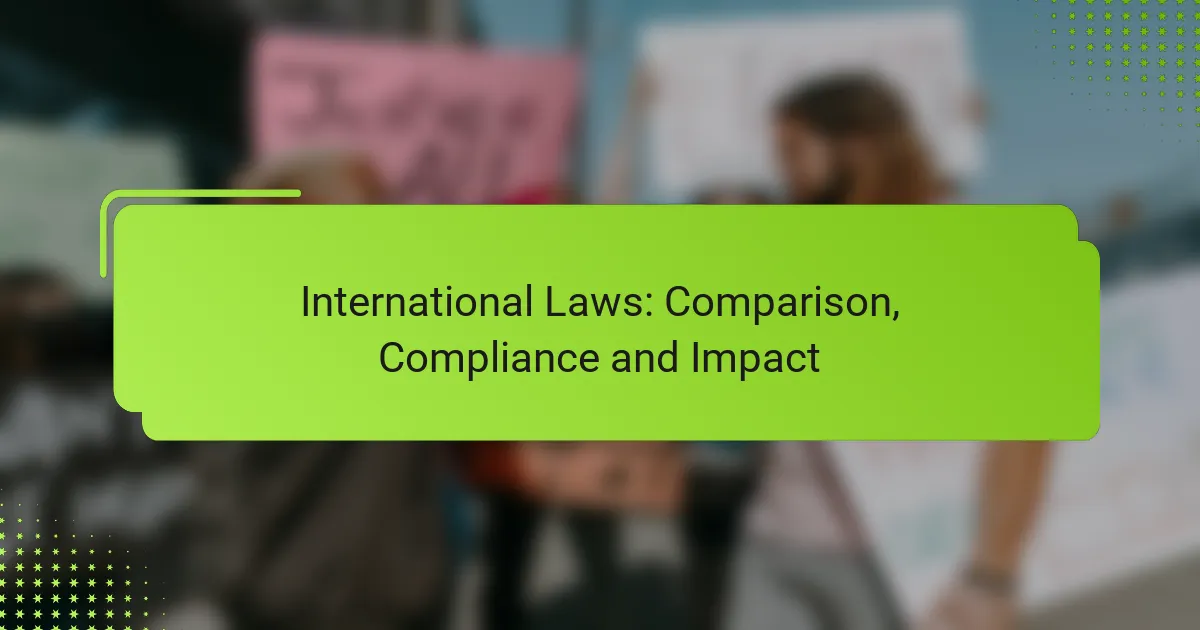Fair Use in the United States permits limited use of copyrighted material without the need for permission from the copyright owner, serving purposes such as education, news reporting, and parody. It is essential to understand the four key factors that courts evaluate to determine whether a specific use qualifies as fair, as this knowledge helps individuals navigate copyright laws responsibly and avoid potential legal issues.
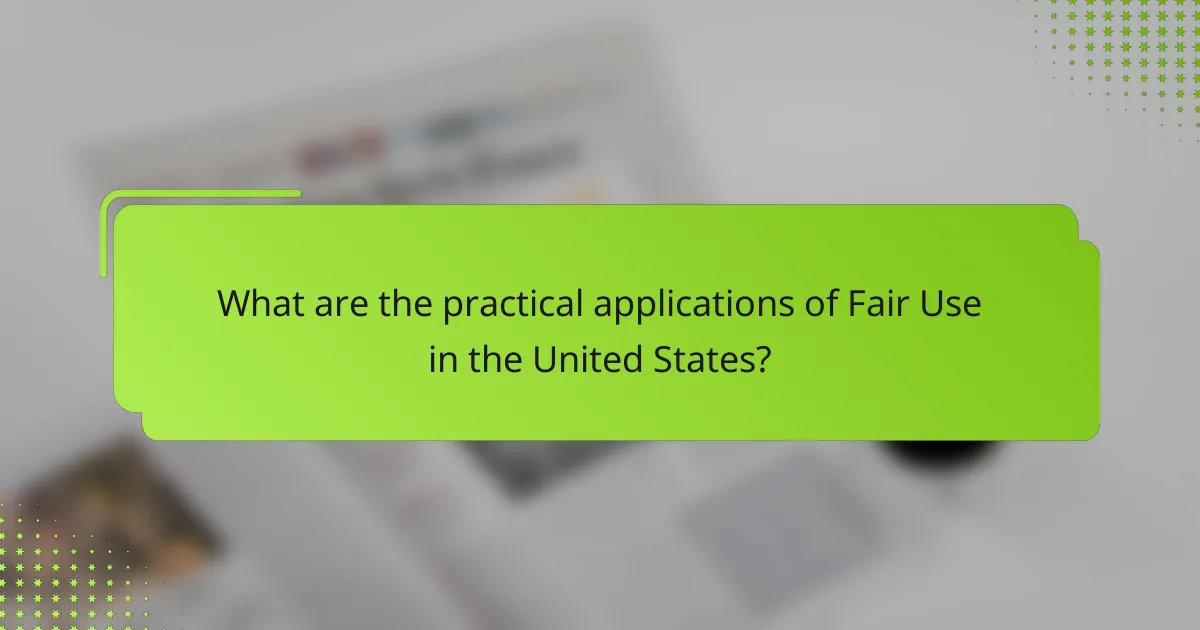
What are the practical applications of Fair Use in the United States?
Fair Use in the United States allows limited use of copyrighted material without permission from the copyright owner, primarily for purposes such as education, news reporting, parody, research, and transformative use. Understanding these applications helps individuals navigate copyright laws while leveraging creative works responsibly.
Educational purposes
Fair Use is often invoked in educational settings, allowing teachers and students to use copyrighted materials for teaching, criticism, or scholarship. For example, a teacher may photocopy a chapter from a book for a class discussion or use a short video clip in a presentation without seeking permission.
When using materials for educational purposes, it is advisable to limit the amount used to a small portion of the work and ensure that the use is directly related to the educational objective. This minimizes the risk of infringement claims.
News reporting
Journalists frequently rely on Fair Use to report on current events, allowing them to quote or reference copyrighted material to provide context and commentary. For instance, a news article might include a brief excerpt from a speech or a still image from a film to illustrate a point.
To qualify for Fair Use in news reporting, the use should be transformative, adding new meaning or insight rather than merely reproducing the original work. Proper attribution and minimal use of the original content are also critical considerations.
Parody and satire
Parody and satire are recognized as valid applications of Fair Use, allowing creators to comment on or critique original works through humor or exaggeration. A well-known example is a comedic sketch that mimics a popular song to make a social statement.
For a parody to qualify as Fair Use, it must clearly transform the original work and provide commentary or criticism. The amount of the original work used should be limited to what is necessary for the parody to be effective.
Research and scholarship
Researchers and scholars can utilize Fair Use to incorporate copyrighted materials into their work for analysis or critique. This might include quoting a passage from a book or using a graph from a study to support an argument in a research paper.
When relying on Fair Use for research, it is essential to use only the portions necessary for the analysis and to provide proper citations. This practice not only respects copyright but also enhances the credibility of the research.
Transformative use
Transformative use is a key factor in Fair Use, where the new work adds significant new expression or meaning to the original. For example, a documentary that uses clips from a film to provide commentary on its cultural impact demonstrates transformative use.
To strengthen a claim of transformative use, creators should aim to change the original work’s purpose or message. This can involve altering the content, adding new insights, or presenting it in a different context, thereby reducing the likelihood of copyright infringement.

What are the limitations of Fair Use?
The limitations of Fair Use primarily revolve around four key factors that courts consider when determining whether a specific use qualifies as fair. These factors include the commercial impact of the use, the amount of work used, the nature of the original work, and the purpose and character of the use.
Commercial impact
The commercial impact of a use refers to whether it affects the market for the original work. If the use competes with the original or diminishes its market value, it is less likely to be considered fair. For example, if a new film uses a significant portion of a copyrighted song, it may harm the song’s sales, thus weighing against a fair use claim.
Amount of work used
This factor examines how much of the original work is used in the new creation. Generally, using a small portion of a work is more likely to be considered fair use than using a large portion. For instance, quoting a few lines from a book for commentary may be acceptable, while reproducing an entire chapter would likely not be.
Nature of the original work
The nature of the original work plays a role in fair use determinations. Creative works, such as novels and films, receive more protection than factual works, like news articles or scientific papers. Therefore, using factual content for educational purposes may be more likely to qualify as fair use compared to using a fictional story.
Purpose and character of use
This factor assesses whether the use is transformative or serves a different purpose than the original. Uses for criticism, comment, news reporting, teaching, or research are more likely to be deemed fair. For example, a parody that comments on the original work can be considered transformative and thus fair use, while simply replicating the original for profit would not.

How does Fair Use differ from copyright infringement?
Fair use allows limited use of copyrighted material without permission, while copyright infringement occurs when someone uses that material without authorization in a way that violates the copyright holder’s rights. Understanding the distinction is crucial for creators and users of content to avoid legal issues.
Legal definitions
Fair use is a legal doctrine in the United States that permits certain uses of copyrighted works for purposes such as criticism, comment, news reporting, teaching, scholarship, or research. The determination of fair use considers factors like the purpose of use, the nature of the copyrighted work, the amount used, and the effect on the market value of the original work.
In contrast, copyright infringement is the unauthorized use of a copyrighted work that violates the rights of the copyright owner. This can include reproducing, distributing, or displaying the work without permission, leading to potential legal consequences.
Consequences of infringement
The consequences of copyright infringement can be severe, including monetary damages, statutory damages, and even criminal penalties in extreme cases. Copyright holders can sue for damages that may range from hundreds to millions of dollars, depending on the severity and scale of the infringement.
Infringers may also face injunctions that prevent further use of the copyrighted material, which can disrupt business operations or personal projects. To avoid these outcomes, individuals and organizations should seek permission or ensure their use qualifies as fair use before utilizing copyrighted works.
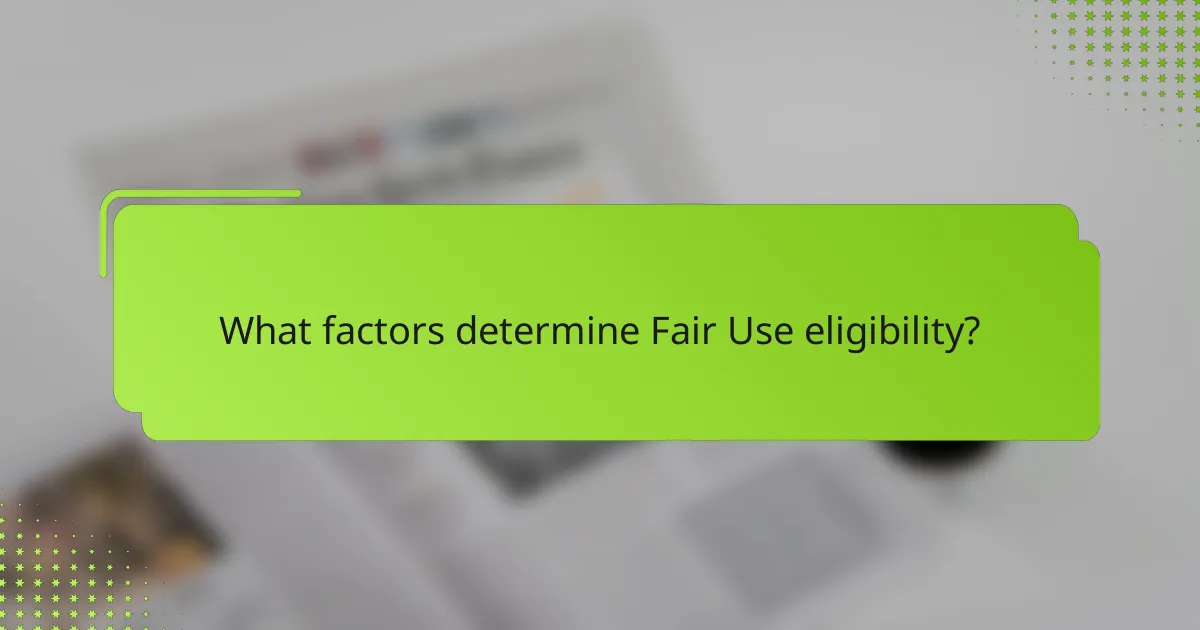
What factors determine Fair Use eligibility?
Fair Use eligibility is determined by a combination of factors that assess how a particular use of copyrighted material aligns with legal standards. The evaluation typically considers the purpose of the use, the nature of the copyrighted work, the amount used, and the effect on the market value of the original work.
Four-factor test
The Four-factor test is a legal framework used to evaluate Fair Use claims. The first factor examines whether the use is for commercial or educational purposes; educational uses are more likely to qualify as Fair Use. The second factor looks at the nature of the copyrighted work, with factual works receiving more leniency than creative works.
The third factor assesses the amount of the work used in relation to the whole; using a small portion is more favorable for Fair Use. Finally, the fourth factor considers the effect of the use on the market for the original work, where a negative impact can weigh against Fair Use eligibility.
Judicial precedents
Judicial precedents play a crucial role in shaping Fair Use interpretations. Landmark cases, such as *Campbell v. Acuff-Rose Music, Inc.*, established that transformative use—where the new work adds something new or alters the original—is a strong indicator of Fair Use. Courts often reference these precedents to guide their decisions on similar cases.
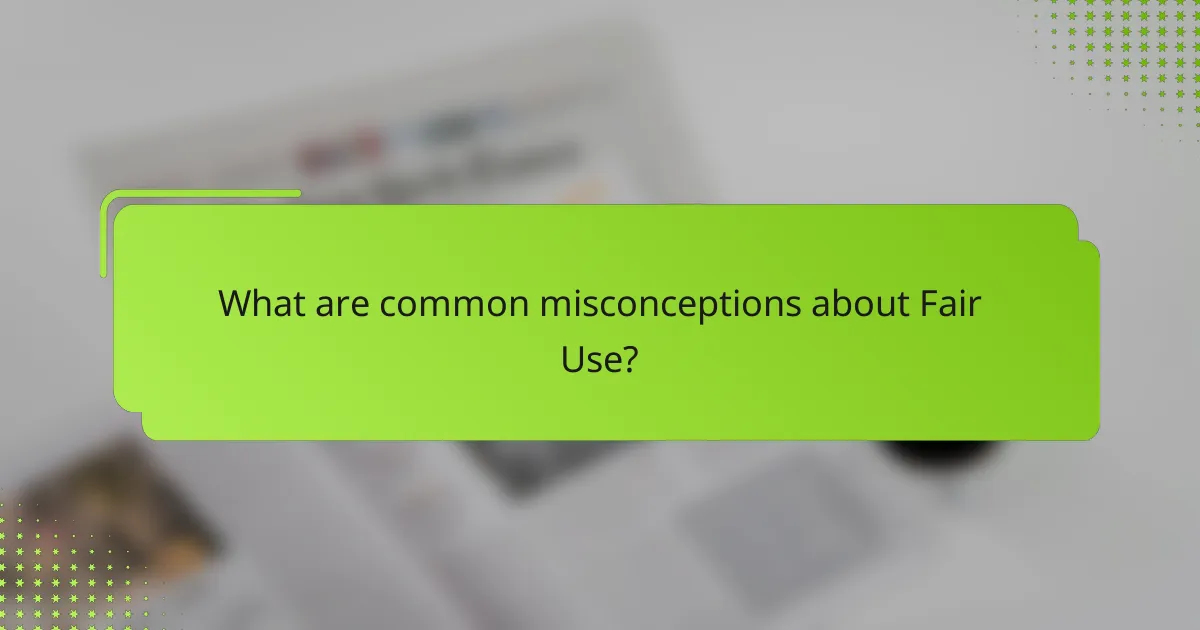
What are common misconceptions about Fair Use?
Many people mistakenly believe that Fair Use allows for unrestricted use of copyrighted material. In reality, Fair Use is a limited doctrine that permits specific uses of copyrighted works under certain conditions.
Fair Use applies to all copyrighted material
One common misconception is that Fair Use can be applied to any type of copyrighted content, including music, literature, and visual art. However, the application of Fair Use can vary significantly depending on the type of work and its intended use.
For instance, using a short excerpt from a book for educational purposes may qualify as Fair Use, while reproducing an entire song for a commercial project likely does not. Understanding the nuances of Fair Use for different types of works is crucial.
Fair Use is a blanket permission
Another misconception is that Fair Use serves as a blanket permission to use copyrighted material without consequences. In reality, Fair Use is determined on a case-by-case basis, considering factors such as purpose, nature, amount used, and market effect.
For example, using a small portion of a work for commentary or criticism may be allowed, but using a significant portion for profit could infringe on the copyright holder’s rights. It’s essential to evaluate each situation carefully to avoid potential legal issues.
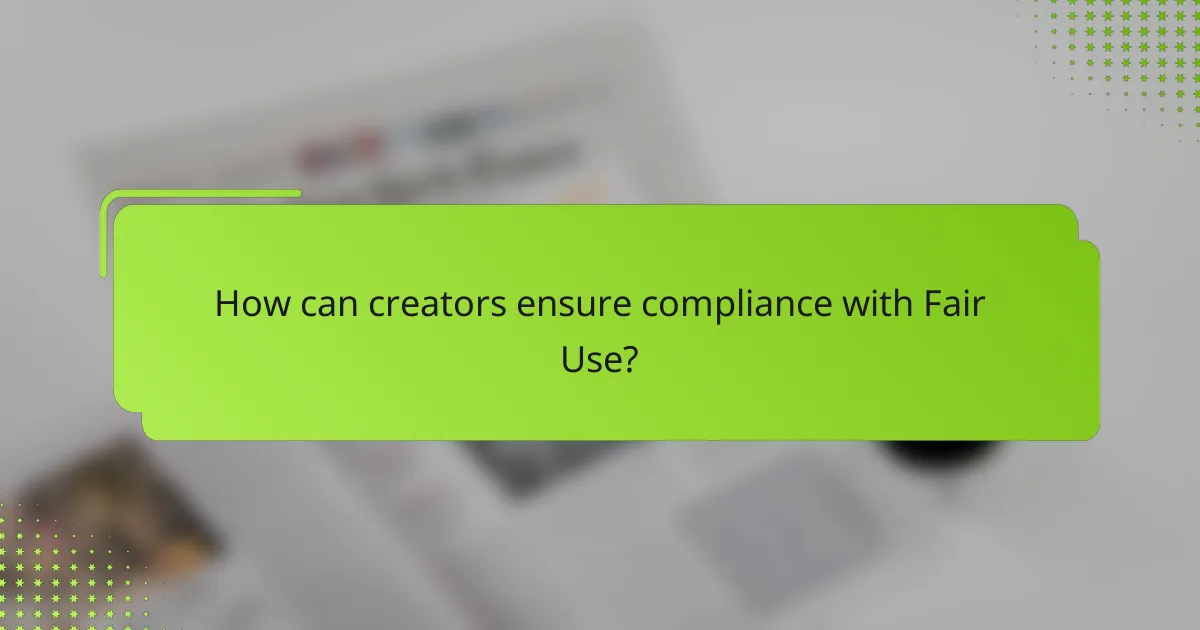
How can creators ensure compliance with Fair Use?
Creators can ensure compliance with Fair Use by understanding its principles and applying them judiciously. This involves evaluating the purpose, nature, amount, and effect of their use on the original work.
Consulting legal experts
Engaging with legal experts is crucial for creators seeking to navigate Fair Use. Attorneys specializing in intellectual property can provide tailored advice based on specific projects and help assess the risks associated with particular uses.
Consider scheduling a consultation before using copyrighted materials, especially if the intended use is commercial or could be contentious. This proactive approach can prevent potential legal disputes and financial penalties.
Documenting usage
Keeping thorough documentation of how copyrighted materials are used is essential for demonstrating compliance with Fair Use. Creators should record the purpose of the use, the nature of the original work, and the amount used.
Maintain a log that includes details such as the date of use, context, and any communications with copyright holders. This documentation can serve as evidence if Fair Use is challenged, showcasing the creator’s intent and adherence to legal standards.
